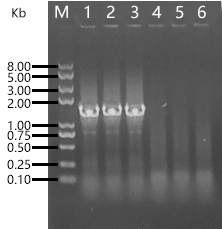Part:BBa_K523000


Plac + lacZ; with BglII site
This is based on part BBa_J33207. Like that part, it contains the lac promoter and codes for 76 N-terminal residues of LacZ (β-galactosidase), a peptide that complements the lacZ-Δ-M15 mutation in common lab strains of E. coli. If these strains are grown on Xgal and IPTG, colonies with this part will be blue.
The part can be used as a promoter or as a cloning vector.
Usage as a promoter
The part can be used simply as a (detectable) promoter. If added upstream of an RBS and coding sequence, a poly-cistronic transcript will be generated with LacZ followed by the other gene.
Usage as a cloning vector
The first four bases of the sequence add a BglII site (BglII sites have 6 bases, but the first 2 are provided by the standard BioBrick prefix). This allows K523000 to be used as a cloning vector for creating new BioBricks in the following way: the forward primer for the new BioBrick should have a BglII site added, and the reverse primer should have a SpeI site added.
The PCR product and the plasmid containing this part can then both be digested with BglII and SpeI. After purification, mixing, ligation, and transformation, colonies with plasmids that have successfully gained the new BioBrick will be white, while those still containing the lacZ part will be blue (on Xgal+IPTG plates).
One might ask: why not use the standard flanking BioBrick sites XbaI and SpeI for this procedure? The answer is that these produce compatible sticky ends and so the new part would circularise. Thus, the normal method is to use one very long primer so the part can be inserted via EcoRI/SpeI or XbaI/PstI. But our method avoids the requirement for such a long primer.
Procedure
To use as a vector for cloning a new part, first PCR the source gene so as to add a BglII site (agatct) upstream of the gene, and a "t" followed by a SpeI site downstream of it (so: t actagt).
The gene must not contain any BglII sites or SpeI sites. However, genes containing EcoRI, XbaI, or PstI sites can be successfully cloned this way; afterwards site-specific mutagenesis must be carried out to remove them, so as to produce an RFC10-compatible BioBrick.
Primers for an imaginary gene might look like this:
- Forward: aaa agatct atg tat tcg gct aat gat
- Reverse: aaa actagt a tta tta gct ttc gtg gca gat cca
(The "aaa" bases are just to give the restriction enzymes room to work.)
After PCR, purify the PCR product and then follow this procedure... (or something similar. This is Edinburgh 2011's exact procedure. For detailed protocols, see the [http://openwetware.org/wiki/French_Lab Open Wetware: French Lab] page.)

Replate some white colonies, then miniprep them and carry out verification sequencing. You should now have an RFC10-compatible BioBrick with a full prefix and suffix. The first four bases of the part will be "atct". For an example of a BioBrick produced in this way, see BBa_K523002.
Parts produced in this way will also be compatible with Edinburgh's 2011 BioSandwich protocol (BBF RFC 81), though its use is entirely optional.
Sequence and Features
- 10COMPATIBLE WITH RFC[10]
- 12COMPATIBLE WITH RFC[12]
- 21COMPATIBLE WITH RFC[21]
- 23COMPATIBLE WITH RFC[23]
- 25COMPATIBLE WITH RFC[25]
- 1000COMPATIBLE WITH RFC[1000]
Characterization : YAU-China 2019
YAU-China team verified the function of this part in E.coli and got the following results:
Then we tested the gene connection efficiency of the plasmid and the proportion of its positive colonies.
This is our transformation diagram of four groups of plasmids.
Results: the correct rate of positive cloning was 97.5%.
Functional Parameters: Austin_UTexas
Burden Imposed by this Part:

Burden is the percent reduction in the growth rate of E. coli cells transformed with a plasmid containing this BioBrick (± values are 95% confidence limits). This BioBrick did not exhibit a burden that was significantly greater than zero (i.e., it appears to have little to no impact on growth). Therefore, users can depend on this part to remain stable for many bacterial cell divisions and in large culture volumes. Refer to any one of the BBa_K3174002 - BBa_K3174007 pages for more information on the methods, an explanation of the sources of burden, and other conclusions from a large-scale measurement project conducted by the 2019 Austin_UTexas team.
This functional parameter was added by the 2020 Austin_UTexas team.
| None |





